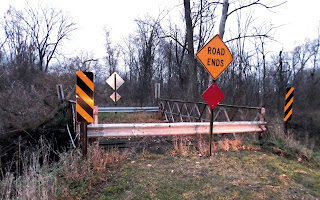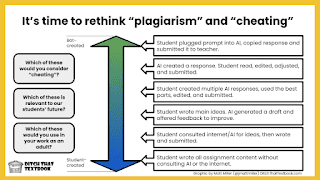Am I the only one overwhelmed by the possibilities of adding AI to my classrooms?
Why do the articles that state 3 Simple Ideas for Introducing AI Into Your Teaching seem neither simple nor helpful?
I find myself searching for the bridge, the path from the way I've been using curriculum to the future where AI is a natural aid in my students' learning experiences.
I find myself researching how to build a bridge.
I'll share my successes and failures below.
AI Detectors
 |
| From Wikimedia Commons, the free media repository |
In the Spring of '23, I had success with a 1-2 approach to investigating suspicions of AI use, which I coupled with a cooperative approach to teaching students about proper AI use.
Currently, in the Fall of '23, I find this approach is falling short. As I suspected, AI tools accelerate much faster than detectors. While in the future, owners of LLMs may be incentivized to detect AI-generated text, at this time, there is no objective tool that can reliably detect AI-written essays. There are a number of tools, but flipping a coin is just as effective.
The only way to know if students are using AI is to become familiar with AI-generated writing and the best way to gain this familiarity is to use it. Teachers who are avoiding (or banned from ) using AI will be at a serious disadvantage in addressing inappropriate AI usage. More importantly, they will not be able to educate students on correct AI usage.
Some ideas for AI use for teachers might be:
- Drafting emails to maintain a positive tone in difficult situations.
- Brainstorming accommodations for IEPs.
- Creating leveled text for differentiation.
- Create multi-leveled exemplars for assignments.
Talking to Students
Once a teacher has a handle on how AI writes and begins to naturally identify some of its shortcomings, it is time to talk to students. I have taken two approaches to this:
Talk to students when AI is suspected.
I send a message like this: Hello there! Thank you for submitting your assignment. Unfortunately, I wasn't able to verify if you met all the requirements based on what was submitted. Don't worry though, we can easily rectify this by scheduling a video chat to discuss your work and go over some best practices in using tools like AI. Let's work together to ensure you get the credit you deserve! Schedule a meeting here. Notice the approach is non-accusatory and does not take a stance of punishment but rather of education. It is important to note that students have not received formal guidance on the appropriate use of AI. Students 13-18 are still developing several important brain functions in regard to impulse control and reasoning.Talk to students proactively.
Host sessions on the appropriate use of AI. Give them tips and tools. Most importantly, educate them on what AI cannot do. Relate AI to something they can understand and explain the benefits and pitfalls clearly. Most importantly, model good AI use ethics by using citations where appropriate and guiding them by identifying the parts of assignments that benefit from proper AI use. Encourage students to use this tool, where appropriate, to help them where they struggle. This might include summarizing, translation, or troubleshooting. AI can be a powerful tutor if students are shown how to use effective prompt engineering.Designing Key Assignments
While AI is predicted to be a major disruptor in education moving forward, what is a teacher to do in the moment, when, halfway through a unit, she realizes that key elements are not AI-proof? There is hope!
After reflecting on the steps above, I began to reflect on why my students are using AI. I came up with two major factors:
1. Procrastination: When students were behind, they tended to turn to online "tools" such as assignment generators and now AI.
2. Lack of Motivation: When students fail to see the value or feel connected to assignments, cheating doesn't seem to be that big of a deal. They are just checking a box. I chose to tackle these two factors.
Time Management:
- I revisited pacing guides in my online classes. I made sure they were up-to-date, usable, and personalized.
- I made video tutorials to show students how to use the pacing guides.
- I built in incentives for the use of pacing guides, such as bonus points if they shared their current progress with me and a learning coach.
- I made sure the workload was appropriate for the course. As the semester progresses, I continue to evaluate the workload per student to ensure it is fitting for each.
Motivation:
While I cannot rewrite a British Lit course in my spare time, I can evaluate the assessments and choose a few to revamp. I chose to add Reading Choice Boards that I reuse several times per semester. These allow students maximum voice and choice in how they demonstrate the reading of the material they select.
I also chose two written assessments and added mini-choice boards (Sonnet 18 and Literary Movements) that focus on how the material impacts a student personally. AI does not have a great ability to make meaningful connections, so this both makes the assignment a little more AI-proof and adds meaning for students. Adding student interaction also ups the personal connection and disincentivizes AI use while maximizing quality teaching strategies.
It is important to note that while AI necessitated the creation of new assignments, it also facilitated them. I used AI tools in Canva, among others, to draft the language and create the rubrics for the assignments. See more in my previous post.
.png) |
| Imgflip.com |
Helping Staff
It is clear that AI has educators in an unfamiliar place: without many answers. Many seem baffled that no one has this figured out, which emphasizes that this is more disruptive than maybe anything in recent memory. Districts keep looking for policy guidance from others, which only has administrators chasing in circles. A recent survey by the Center for Digital Education of 132 educators found that 55% of schools have no policy for students and 74% have no policy for staff.
It is imperative to continue having conversations and to share what works and what doesn't. This situation will continue to develop for months and years to come. What I did last spring no longer works this fall. Things I've tried this fall likely will have a short shelf life as well. Teachers can help one another by sharing tools, tips, and tricks. Administrators can help teachers by giving them time and space to make adjustments throughout the year and support them in trying when we know what is tried may not work.
Everyone needs to give grace, to teachers and students, as we learn to live in this reality. We've navigated the invention of the calculator and the internet and outlasted fads such as laserdiscs, MySpace, and Napster only to come out richer for it with more students taking Calculus, Coding and enjoying streaming music and movies. While reflecting on 'net nastaglia and attempting to predict the future, one tech writer quipped, "Look for the thing everyone is laughing at."
The End is the Beginning
In this ever-evolving landscape of education, the integration of AI has undoubtedly introduced both excitement and challenges for educators like myself. As I've journeyed through the uncharted territory of AI in the classroom, I've found myself questioning, adapting, and innovating. The path forward, while not always clear, has been filled with valuable lessons and insights.
My exploration of AI detectors has been a rocky one. Yet, as educators, we mustn't shy away from AI but rather embrace it. To truly understand AI and its implications, we must immerse ourselves in its capabilities. By doing so, we not only stay ahead of our students but also equip ourselves to educate them effectively. To guide our students toward responsible AI usage, we need to lead by example.
The journey may be challenging, but it is one that holds the promise of enriched learning experiences and empowered students.


Comments
Post a Comment